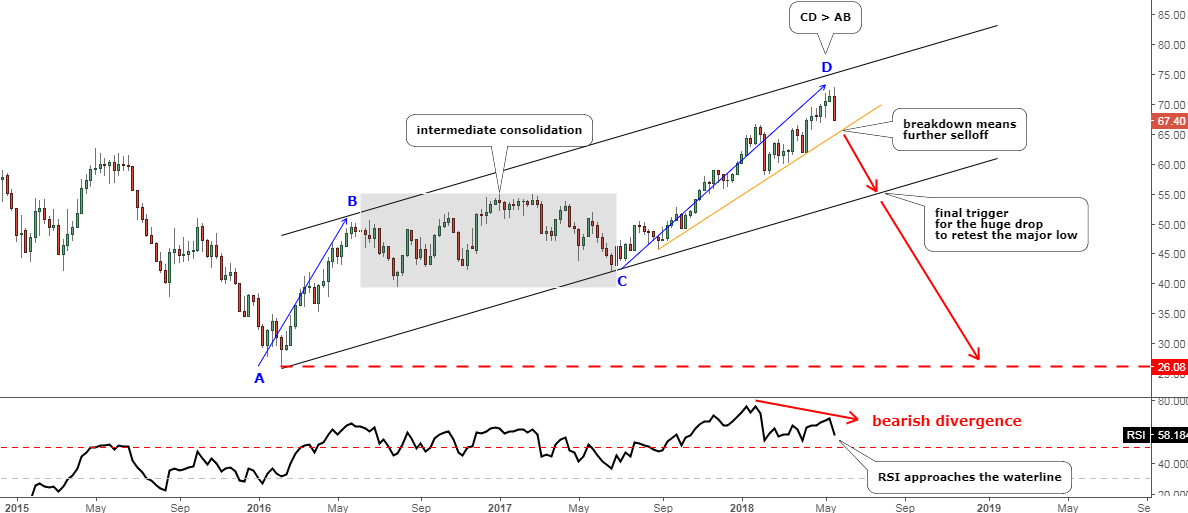It is interesting how often exaggerated expectations prove to be wrong in the market. Crude oil is the dominant fossil fuel energy source, and therefore it draws a lot of attention as well as speculation.
Looking back, I remember a conversation with my boss earlier in the year who had talked to a large oil producing company and they said that it is highly improbable for crude oil to get over $55 per barrel amid the supply glut. WTI crude almost hit the $73 level this month to break similar pessimistic forecasts that had persisted in the market last year. OPEC’s deal together with Middle East tensions has driven the oil price to a 3-year high benefiting oil producing countries.
But these days I have started to hear different highly optimistic forecasts calling for $80-100 per barrel. When these voices began to grow into a full choir, I began to expect the thunder as this “sweet unison” is the leading contrarian indicator.
The final confirmation I received was from the latest interview of the Russian tycoon and the president of the LUKOIL company (#1 private oil company by oil reserves in the World) (LUKOY) Vagit Alekperov, who said that his company doesn’t plan to increase the budgeted oil price as he believes that current high levels are speculative amid rising reserves to increase oil production accumulated from the agreed limitation (OPEC+ can unwind/cut deal anytime). He thinks that US oil producers would catch this chance to fix the high price by selling futures to hedge production costs to extend a profitable production cycle.
It didn’t take too long to see how market stopped its growth and started to drop quickly last week. And in the chart below I would like to share with you my technical view of crude oil to see if it has peaked already.
Chart 1. WTI Crude Oil Weekly: Large Complex Correction Could Be Over

Chart courtesy of tradingview.com
This chart above started from the period when the considerable drop of crude oil reversed to the upside in 2016. It was a short squeeze as panic selling always attracts speculative buyers who clearly understood that it was too early to bury this fossil fuel. The price quickly restored its losses and hit the $51 handle where the earlier sell-off had started. I marked that strong move up as an AB segment (blue).
Every strong move is followed by a consolidation, and it wasn’t a surprise that the price stopped rising and started to move in a sideways direction as the market reached some kind of equilibrium there. As I wrote many times before, this market stage can be tricky and time-consuming. I highlighted the intermediate consolidation with the gray box with the downside at the $39 level and upside at the $55 level. It took 54 weeks, which is more than three times longer than the period of AB segment (17 weeks).
At the end of last June, another rally started at the $42.66 level. It has an extended period as it took 47 weeks to peak at $72.88 compared to 17 weeks in the first run and 54 weeks in the consolidation. In spite of this, the price couldn’t get the same extension as the CD segment is equal only to 1.15 of the AB segment although it is still more significant. Crude oil couldn’t hit the upside of the black uptrend at the $75 level despite overly optimistic calls.
What’s next? Let me clarify the main thing about the structure, which is contoured with the black uptrend. It is not a growth structure. This is a large complex correction to the upside. It consists of two upside moves (AB/CD) with a consolidation in between. The angle of the trend is below 45 degrees, which tells about the weak growth.
Shall we deem this recent drop as a start of another big crash? Let us see if we have some indicators pointing at this. We got more than one. The first and the second are the distance and the time spent by the CD segment. As I mentioned above the CD segment is already 1.15 times larger in price change and more than three times longer than the AB segment in spent time. Furthermore, the whole consolidation structure already took 27 months compared to 20 months of the massive drop from $108 to $26, which makes it 1.35 times longer. So we are definitely at the stage when the time should expire for the growth.
Another downside factor is the accumulated Bearish Divergence on the RSI. The combination of the lower tops on the RSI sub-chart diverges with the series of higher peaks on the price chart. This is a warning signal as it is the weekly time frame. Moreover, the indicator dangerously approaches the waterline at the 50 level. The drop below it would confirm the further sell-off as well as the breakdown of the first trigger below the orange support ($64 area).
The final trigger for the huge drop would occur below the downside of the black channel ($53-$55 area). The WTI could retest the major low established in 2016 at the $26 level then.
Please share your comments and outlooks below.
Intelligent trades!
Aibek Burabayev
INO.com Contributor, Metals
Disclosure: This contributor has no positions in any stocks mentioned in this article. This article is the opinion of the contributor themselves. The above is a matter of opinion provided for general information purposes only and is not intended as investment advice. This contributor is not receiving compensation (other than from INO.com) for their opinion.


I think, most crude oil players need more and more cash to sustain their Economies, so alliance honeymoon period may be over, and now, to capture maximum market share, price under cutting fight will be taken place, between Opec, US Shell Oil,, Russia and Iran.
As I wrote in my earlier post, for WTI, $ 74 and S 76 are big hurdles, so further bull run can be expected only after the levels, in down side $ 58 and $ 53 are major supports for continuing or sustain present position.
THE OPEC HAVE DECIDED TO INCREASE PRODUCTION OF OIL; BUT THE DECISION WILL BE IMPLEMENT O N 6TH JUNE MEETING .
THE POLITICAL COMMODITY CRUDEOIL PRODUCTION INCREASED BY US AND PRODUCTION INCREASED BY OPEC COUNTRIES WILL CERTAINLY IMPACT RESULTED INTO FALL IN PRICE